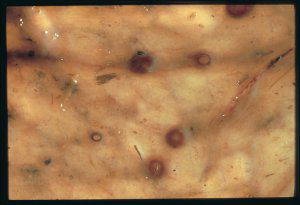 London, UK – Feb 05, 2019 – Zoetis Inc. today announced that recent cases of serious disease caused by severe encysted small redworm infections have prompted Zoetis vet Wendy Talbot to remind horse owners of the risks posed by not treating for this potentially fatal parasite.
London, UK – Feb 05, 2019 – Zoetis Inc. today announced that recent cases of serious disease caused by severe encysted small redworm infections have prompted Zoetis vet Wendy Talbot to remind horse owners of the risks posed by not treating for this potentially fatal parasite.
In the spring the small redworm larvae can erupt from their hibernation inside the horse’s gut in large numbers, breaking and damaging the lining of the intestinal wall. Symptoms include diarrhoea, weight loss and colic. This condition (known as larval cyathostominosis) can be fatal. Young horses (<6years old) have the highest risk although all ages may be affected.1,2,3
“Over the past few weeks I have heard of a number of cases of larval cyathostominosis,” says Wendy. “Unfortunately people think their horses are safe from this parasite if they have had a recent, negative faecal worm egg count (FWEC) but this absolutely is not the case. Because encysted small redworm are hibernating, they won’t show in faecal worm egg counts. A horse could actually have a burden of several million encysted small redworm larvae yet show a negative or low FWEC.” 2
Currently there is no effective test for encysted stages of small redworm. All horses of more than six months of age should be dosed for it ideally during the late autumn/early winter and certainly before the spring arrives.
There are only two active ingredients licensed to treat encysted small redworm: a single dose of moxidectin or a five-day course of fenbendazole. However, there is widespread evidence of resistance in small redworm to fenbendazole, including the five-day dose so a resistance test is recommended before using it.2 Moxidectin has high efficacy against adult small redworm including encysted mucosal larvae.4
“It’s imperative to use the right worming product,” says Wendy. “Treating with a wormer that does not specifically target the encysted stages (ivermectin, pyrantel or single dose fenbendazole) during late autumn and winter can actually increase the risk of a horse with a high ESRW burden developing larval cyathostominosis.” 3
Always make sure you choose the right worming methods and products for your horse’s circumstances by discussing your worming programme with your prescriber.
Learn more about why encysted small redworm are a serious health risk to horses by watching this video http://bit.ly/2AigdIR You can also visit www.horsedialog.co.uk to read some helpful articles on equine health and wellbeing.
Search
Recent Articles
- How to take a horse from SHOES to BAREFOOT with Alex Ridgeway & Dr Mark Caldwell
- 8 Laminitis Myths Busted!
- I’ve learnt as I’ve got older to really listen to what the people around me say about others
- The dangers of sleep deprivation in horses
- The third part of our series on stretching and flexibility with Sharon Stuart or Stuart Equine – forelimb and neck stretches for the horse and shoulder stretches for the rider
Categories
- Advice Hub
- Athlete
- Carriage Driving
- Dentistry
- Dressage
- Endurance
- Eventing
- Farrier
- Featured
- Featured Horse Ads
- Featured Posts
- Horse Racing
- Horse's Mouth
- Horseball
- Hunting
- Le Trec
- Leisure Riders
- Mounted Games
- Nutrition
- Polo
- Polocrosse
- Reining
- Rescue & Rehabilitation
- Show Jumping
- Showing
- Tack Room
- Team Chasing
- The Pony Club
- Therapy
- Training
- Vaulting
- Veterinary


